#this one's stańczyk by jan matejko
Explore tagged Tumblr posts
Text

138 notes
·
View notes
Text



Neil said on a recent panel Astarion is a harlequin so I doodled sth to celebrate that
#my art#digital art#astarion#harlequin#harlequin astarion#astarion fanart#the 2nd one is referencing “Stańczyk” by Jan Matejko
318 notes
·
View notes
Text
bless my dad for obsessing over the appearance of polish art on the back cover of lady gaga’s new harlequin album i raised that man so well
#i’m so proud#he’s even having theories on what she might be planning!#so cute#I was like yeah yeah and he goes BUT WHAT IF THAT MEANS SHE PLANS TO RETURN TO POLAND ON TOUR#dearest dad that would mean me saying goodbye to all my concert savings#and me being very happy#she was once here on tour ages ago and my parents said i was too young to go (fair - i was 12) and they refused to go with me#they know very well i still hold a grudge#even though i did get to see her in 2014 when i was 17#lady gaga#lg6.5#harlequin#listening party for one in 4 hours let’s gooooooooo#joker: folie à deux#stańczyk#jan matejko
4 notes
·
View notes
Text
Ah yes, deploring over the future of the country. Seeing the state the whole world is in bet not only Poles relate to that sentiment [context]

Pomńczyk
#if you don't wanna click on [context] then it's a link to the wiki article about the Stańczyk (Jester) paiting by Jan Matejko#basically the one person who should be happy silly etc is presented like that because the future of Poland is going to shit#meanwhile the ruling class has a party about it#very universal both regarding the worldwide political situation as well as “this fucking sucks and I'm stuck here”#which political or not still checks out for a lot of people in various situations#(no one asked but I just wanted my school knowledge to be useful for once sorry)
843 notes
·
View notes
Text
Current mood:

#drunk skunk#current mood#Stańczyk during a ball at the court of Queen Bona in the face of the loss of Smolensk#Jan Matejko#lotta emotions in this one lads
1 note
·
View note
Text
SET SEVEN - ROUND TWO - MATCH ONE
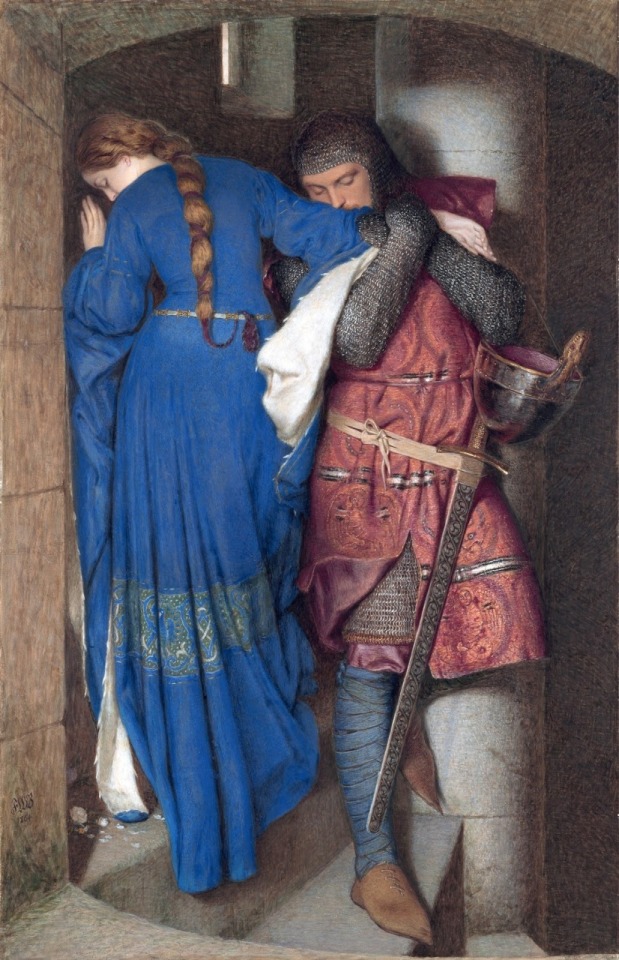

"The Meeting On The Turret Stairs" (1864 - Frederic William Burton) / "Stańczyk" (1862 - Jan Matejko)
THE MEETING ON THE TURRET STAIRS: The fact that it's watercolor… Jesus Christ, Dude. Also I am biased because I run a weekly scheduled post for it (Meeting on the Turret Stairs Tuesday) so I would be letting myself down not reblogging it haha (@dorknewton)
STAŃCZYK: this piece pictures a jester contemplating the political disasters befalling the country, presumably as the court is celebrating in the other rooms. it takes place when the polish nobility was essentially selling out the territories to neighbouring regimes, ignorant of the fact they were issuing a permission for colonisation and oppression of their own people. while it’s context is extremely specific, it remains to feel relevant considering the actions of those in power even in the modern society. i think the climate anxiety has a similar vibe; feeling like you’re isolated in your care while the higher ups are celebrating their own greed. (anonymous)
("The Meeting on the Turret Stairs" is a watercolor painting by Frederic William Burton. It measures 95.5 x 60.8 cm (37.6 x 24 in) and is held by the National Gallery of Ireland.
"Stańczyk" or "Stańczyk during a ball at the court of Queen Bona in the face of the loss of Smolensk" is an oil on canvas painting by Jan Matejko. It measures 120 cm × 88 cm (47 in × 35 in) and is held by the Warsaw National Museum.)
793 notes
·
View notes
Text
Stańczyk by Jan Matejko (1862)
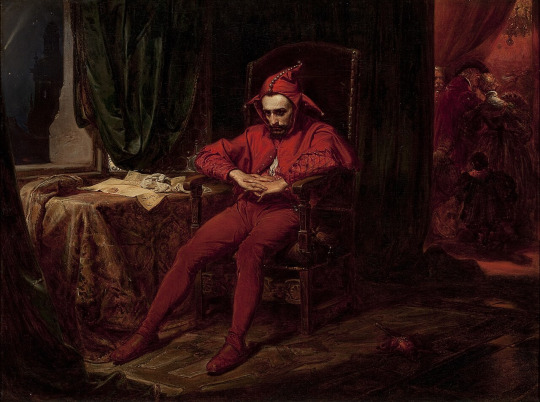
Description from Britannica (author: Ann Kay)
Stańczyk, oil painting created in 1862 by Polish artist Jan Matejko. It is one of Matejko’s best known works and is an iconic image in Poland.
Historical painting has always been a vital thread in Polish art, and Matejko chronicled Polish history with a verve and romance that earned him a central place in his homeland’s artistic consciousness. Court jester to several Renaissance-era Polish kings, Stańczyk was said to be a man of extraordinary wisdom. Not afraid to wield his satirical wit to criticize those in power, he came to personify the fight for truth over hypocrisy and even Poland’s struggle for independence.
In this painting, Matejko has turned the jester into a symbol of his nation’s conscience. While a ball at the court of Queen Bona (wife of Sigismund I the Old) is in full swing, Stańczyk sits slumped in depression, having just discovered—presumably indicated by papers on the table—that the Polish city of Smolensk has been lost (1514) during war with Moscow. Seating him apart from the rest of the court emphasizes that only he foresees that the war will be disastrous for Poland.
Matejko’s characteristic theatricality and lighting make the painting appear like a scene from a play. The principal player, in a fanciful costume that highlights his seriousness by its contrast, is placed centrally in a spotlight. In the wings, we glimpse the bit players, while outside a window a comet falls portentously. The face is a self-portrait of Matejko himself, and the artist’s finely detailed style adds to the mood, picking out everything from the plushness of the drapes to the distant sparkle of a chandelier. For centuries Stańczyk featured in the work of an array of Polish artists and writers, but this striking image is the one that has endured.
ABOUT THE AUTHOR -
Ann Kay is a writer and editor with a degree in the history of art and literature at Kent University and a postgraduate qualification in graphic design from London University. She has also studied book design and jewelry-making. Her work appears in Encyclopaedia Britannica as part of a joint publishing agreement with the publisher of 1001 Paintings You Must See Before You Die and 1001 Amazing Places You Must See Before You Die, where the work originally appeared.
#history#history of art#art history#art hoe#art#classical art#artists on tumblr#stańczyk#stanczyk#poland#polish art#polish tumblr#polish history#polska#polishposting#polblr#wroclaw#germany#central europe#warszawa#krakow#europe#european history#european art#political angst#political art#global politics#politics#polish politics#polish painters
62 notes
·
View notes
Text
Yay, finally finished this Jon as the Fool of the tarot game...let's see if i can keep it up this time ! (next one would be Bran !)

closeup !

Inspiration for Jon's position ! "Stańczyk (court jester) during a ball at the court of Queen Bona in the face of the loss of Smolensk" by Jan Matejko
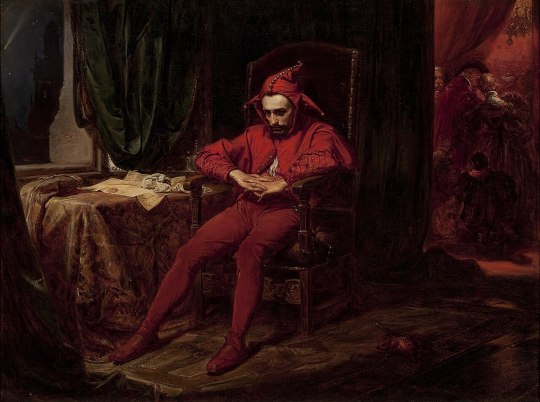
#jon snow#the wall#ghost asoiaf#ygritte implied#longclaw#you know nothing jon snow !#asoiaf art#valyrianscrolls#asoiaf art project#tarot deck#the fool tarot
24 notes
·
View notes
Text
round 3, poll 2
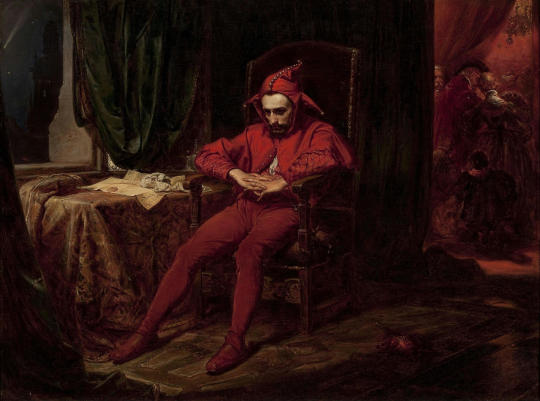
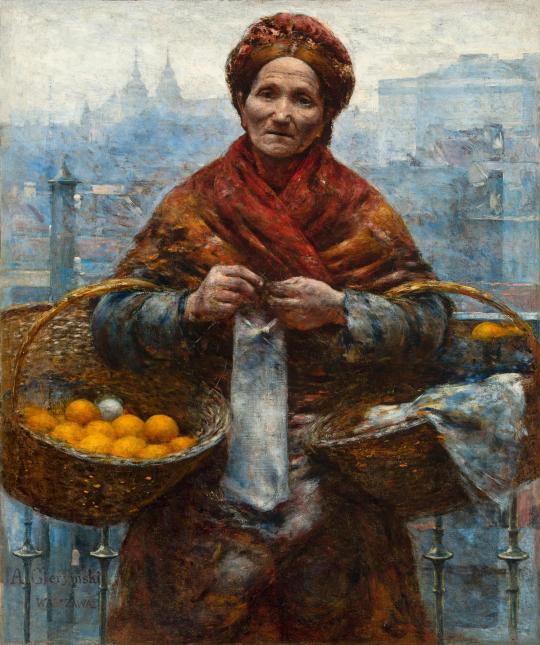
Stańczyk:
painted in 1862
i generally dislike matejko but stańczyk is so iconic that i've grown to like it
long story short Stańczyk was a court jester for the last kings of the Jagiellonian dynasty in Poland in 16th century. he was also politically savvy and known for his accurate satirical comments on the country's past and present political situation.
in the painting he has just read the letter announcing some significant war losses (the fall of Smolensk); he is somber, but in the background, behind the curtain, the royals having fun at a ball and remain ignorant of the news
it's one of Matejko's early paintings; he was just 24 when he finished it
it's also an autoportrait since Matejko gave Stańczyk his own face
Żydówka z pomarańczami:
painted in 1881
looted during ww2 and recovered after almost 80 years!
portraits of elder people are always so good
there is something very pleasing about the blue-orange colour combination
instead of a live model Gierymski probably used this photo as a reference - the woman really is recognizable!
see more of their works! Matejko, Gierymski
118 notes
·
View notes
Text

Jan Matejko :: “Stańczyk” :: 1862
* * *
“All through my life I've had this strange unaccountable feeling that something was going on in the world, something big, even sinister, and no one would tell me what it was." "No," said the old man, "that's just perfectly normal paranoia. Everyone in the Universe has that.” ― Douglas Adams, The Hitchhiker’s Guide to the Galaxy
29 notes
·
View notes
Text


Just some clowns that I drew. The first one is inspired by Stańczyk by Jan Matejko the other just poofed into existence, I don't even know if his face is a face or a mask...
37 notes
·
View notes
Text
Here's a poll for you about polish paintings
Which one of these paintings do you recognize the most?
1. Rejtan by Jan Matejko

2. Stańczyk by Jan Matejko

3. Bitwa pod Grunwaldem by Jan Matejko

4. Pełzająca Śmierć by Zdzisław Beksiński

#art#polish art#jan matejko#zdzislaw beksinski#classical art#surrealism#baroque art#gothic art#history#historical painting#rejtan#stanczyk#bitwa pod grunwaldem#poll#polls#oscar speaks
37 notes
·
View notes
Note
Have you ever seen the Stańczyk by Jan Matejko? Could you maybe take this request of drawing one of the tsams characters referencing the painting? Or say what character you think matches most with the painting if you don't want to!
THATS SO FUNNY HOW YOU SAY THAT BRO CAUSE IM IN THE MIDDLE OF WORKING- i have a bLOODMOON WIP REFRENCING THAT VERY PAINTING heres a wip as a cute, girly and demure treat i dont know when the FUCK ill ever finish it tho i have so many wips to do 💀

Its in its earlier stages but still 🙄
9 notes
·
View notes
Note
Stańczyk by Jan Matejko?

I've spent the last few days trying to get into this one.
By all means I should have some feelings about it, I want to be able to present to you all a lovely review about it. There's deep, rich colors. The figures in the background are melty and merry compared to Stanczyk, who is in sharp clarity and dreary.
There's a hopelessness to this painting that is deep and evocative, I'm sure, for others.
But, no matter how much I try it's just not my vibe. And believe me, I've tried. I've spent hours staring, I've almost meditatively contemplated it as I've paced my backyard. (Which, I must say, it's lovely here this time of year, the creeping charlie in my lawn looks absolutely lovely).
Still though, this painting eludes me. I have nothing against it, it just evokes very few emotions for me.
Sadly, it's a 0/10 for me, one without malice or contempt.
14 notes
·
View notes
Text

a miserable fool!
[ID: a reference sheet for an original character, kaśka. she is a skinny anthro hare with light brown fur and orange eyes, wearing jester/bard attire. in the centre are two mirrored drawings of her standing with an arm out to the side, one with her clothes and one without. additional drawings to the side: a closeup of her face and a doodle of her sitting on a chair like in the painting stańczyk by jan matejko. End ID]
141 notes
·
View notes
Text
I wonder how many Westerners who use the “pondering jester” image as their avatar picture - you know, this one:

...know that it’s a painting of Stańczyk by Jan Matejko... and that Stańczyk has major significance in Polish history and literature.
107 notes
·
View notes